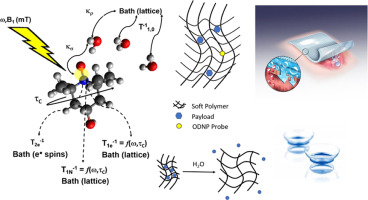Current Opinion in Colloid & Interface Science ( IF 8.9 ) Pub Date : 2018-02-22 , DOI: 10.1016/j.cocis.2018.02.007 Joshua R. Biller , Ryan Barnes , Songi Han

|
Solution state Overhauser dynamic nuclear polarization (ODNP) has been studied for 60 years, but only in recent years has found applications of broad interest to biophysical sciences of hydration dynamics (HD-ODNP) around biomolecules and surfaces. In this review we describe state-of-the-art HD-ODNP methods and experiments, and identify technological and conceptual advances necessary to broadly disseminate HD-ODNP, as well as broaden its scope. Specifically, incomplete treatment of the saturation factor leads to the use of high microwave powers that induce temperature-dependent effects in HD-ODNP that can be detrimental to the stability and property of the sample and/or data interpretation, and thus must be corrected for. Furthermore, direct measurements of the electron spin relaxation times for the nitroxide radical-based spin labels used in HD-ODNP have recently caught up with the ambient solution conditions of relevance to HD-ODNP experiment, allowing us to envision an explicit treatment of the saturation factor. This would enable “single-shot” HD-ODNP at one or two concentrations and power levels, cutting down experimental times from the typical hours to minutes. With the development of a user-friendly and robust operation, the application of HD-ODNP experiments can be broadened for the study of biomolecules, biomaterials, soft polymer materials (i.e. hydrogels) and surfaces. In fact, any hydrated materials that can be viably spin labeled can yield information on local water dynamics and interfaces, and so guide the design of soft materials for medical and pharmaceutical uses. A brief introduction to spin-labeling, and exemplary applications to soft materials is discussed to serve as inspiration for future studies.
中文翻译:

用Overhauser动态核极化研究软材料
解决方案状态Overhauser动态核极化(ODNP)已研究60 几年来,但直到最近几年,生物分子和表面周围的水合动力学(HD-ODNP)的生物物理科学才引起人们广泛的兴趣。在这篇综述中,我们描述了最新的HD-ODNP方法和实验,并确定了广泛传播HD-ODNP以及扩大其范围所必需的技术和概念上的进步。具体而言,对饱和因子的不完全处理导致使用高微波功率,这些高微波功率会在HD-ODNP中引起温度依赖性效应,这可能不利于样品的稳定性和特性和/或数据解释,因此必须针对以下因素进行校正。此外,HD-ODNP中使用的基于氮氧自由基的自旋标记物的电子自旋弛豫时间的直接测量最近赶上了与HD-ODNP实验相关的环境溶液条件,这使我们可以设想对饱和因子的显式处理。这样就可以在一个或两个浓度和功率水平下“一次性” HD-ODNP,从而将实验时间从典型的小时减少到几分钟。随着用户友好和强大操作的发展,HD-ODNP实验的应用可以扩展到研究生物分子,生物材料,软聚合物材料(即水凝胶)和表面。实际上,任何可以进行旋转标记的水合材料都可以提供有关局部水动力学和界面的信息,从而指导医疗和制药用软材料的设计。讨论了自旋标记的简要介绍以及对软材料的示例性应用,以作为未来研究的灵感。



























 京公网安备 11010802027423号
京公网安备 11010802027423号